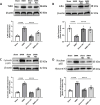Bromodomain-containing protein 4 contributes to chronic postsurgical pain via activating TLR4/NF-kappaB-dependent neuroinflammation
- PMID: 40652178
- PMCID: PMC12254965
- DOI: 10.1186/s12871-025-03216-6
Bromodomain-containing protein 4 contributes to chronic postsurgical pain via activating TLR4/NF-kappaB-dependent neuroinflammation
Abstract
Background: Chronic pain affects 1.5 billion individuals worldwide but remains woefully undertreated, particularly occurring in the populations undergoing surgical procedures. Increasing evidence indicates that epigenetic modifications are involved in the pathogenesis of chronic pain. This study aimed to investigate the role of bromodomain-containing protein 4 (Brd4) in chronification of pain after surgery.
Methods: Male Sprague-Dawley rats were subjected to skin/muscle incision and retraction surgery to induce chronic postsurgical pain. Nociceptive thresholds and locomotor activity were assessed. The spinal cord was collected to detect the expressions of Brd4, toll-like receptor 4 (TLR4)/nuclear factor-kappaB (NF-κB) pathway, and proinflammatory cytokines and chemokines release. The BET inhibitor JQ1 was used to verify the contribution of Brd4 to chronic postsurgical pain.
Results: Significant upregulation of spinal Brd4 expression, accompanied by activation of the TLR4/NF-κB signaling cascade and increased release of proinflammatory mediators were presented in the rat model of chronic postsurgical pain. The BET inhibitor JQ1 prevented the development of chronic postsurgical pain in a dose-dependent manner. Moreover, JQ1 obviously suppressed the activation of TLR4 and the phosphorylation and translocation of NF-κB as well as subsequently cytokines and chemokines release, including IL-1β, IL-6, TNF-α, CXCL1, CXCL2 and CCL2.
Conclusions: The epigenetic regulator Brd4 initiates neuroinflammation in spinal cord through activating TLR4/NF-κB signaling pathway and enhancing cytokine and chemokines release, thereby contributing to the transition to chronic postsurgical pain. JQ1 halts chronic pain development, providing a novel therapy for patients at high risk of persistent pain.
Keywords: Brd4; Chronic postsurgical pain; Epigenetics; NF-κB; Neuroinflammation.
© 2025. The Author(s).
Conflict of interest statement
Declarations. Ethics approval and consent to participate: Animal protocols were approved by the Committee on the Use of Animal Experiments of Tianjin Medical University (No. NSFC-AE-2021131, Tianjin, China) and adhered to the guidelines of the International Association for the Study of Pain. Consent for publication: Not applicable. Competing interests: The authors declare no competing interests.
Figures





References
-
- Sun EC, Mariano ER, Narouze S, et al. Making a business plan for starting a transitional pain service within the US healthcare system. Reg Anesth Pain Med. 2021;46(8):727–31. - PubMed
-
- Glare P, Aubrey KR, Myles PS. Transition from acute to chronic pain after surgery. Lancet. 2019;393(10180):1537–46. - PubMed
-
- Ghosh K, Pan HL. Epigenetic mechanisms of neural plasticity in chronic neuropathic pain. ACS Chem Neurosci. 2022;13(4):432–41. - PubMed
MeSH terms
Substances
Grants and funding
LinkOut - more resources
Full Text Sources
Medical

